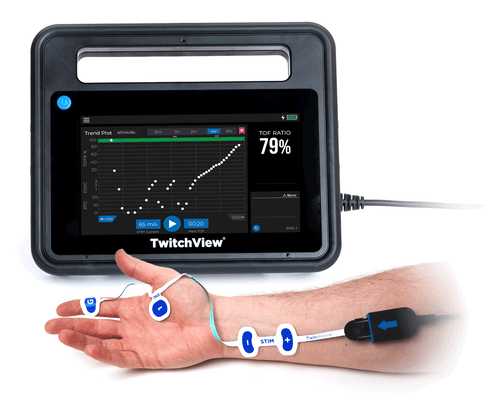Inside the ASA Guidelines: How Aligned Are You?

Are You Aligned with the ASA Guidelines?
When was the last time you reviewed the ASA’s recommendations for neuromuscular monitoring?
If you're like most anesthesia providers, it might have been a while—and that’s not a judgment. It’s a reality of life in the OR: busy schedules, rapid turnover, and constant juggling of demands.
But here's the thing. The ASA guidelines are more than just casual suggestions. They reflect clinical consensus, evolving evidence, and a growing push for patient safety. And with residual paralysis rates of up to 40% in many institutions, the stakes are high.
Residual paralysis is clearly still a problem. In fact, research shows that it not only happens far more often than many assume—but it is hiding in plain sight, as standard clinical assessments fail to catch it. That’s why the ASA issued updated practice recommendations calling for quantitative monitoring, not just subjective or visual checks.
So let’s break it down. What do the ASA guidelines actually say? And more importantly—are you following them?
The 2023 ASA Recommendations: A Clinical Summary
The American Society of Anesthesiologists’ most recent Practice Guidelines for Monitoring and Antagonism of Neuromuscular Blockade were released in 2023. They provide a clear roadmap for clinicians using muscle relaxants and reversal agents.
Here’s what the ASA now recommends:
1. Use Quantitative Monitoring (Objective Devices)
The ASA recommends using quantitative monitors, such as electromyography (EMG) monitors, to confirm full recovery before extubation. Subjective methods (like visual or tactile assessment of TOF) are no longer considered reliable.
“Subjective assessment should not be used as the sole method to evaluate recovery from neuromuscular blockade.”
— ASA 2023 Guidelines
2. Confirm TOF Ratio ≥ 0.9
Objective devices should confirm a train-of-four (TOF) ratio ≥ 0.9 before tracheal extubation. Below this threshold, patients may still have impaired airway reflexes, muscle strength, and breathing capacity—even if they appear outwardly recovered.
3. Understand Why Subjective Methods Fall Short
Clinical tests—like sustained head lift, grip strength, or vital capacity—are not sensitive enough to detect residual neuromuscular blockade (RNMB).
Even when a peripheral nerve stimulator is used, the visual or tactile detection of fade becomes unreliable when TOF ratios exceed 0.4.
This is far below the level considered safe for extubation.
Here’s why relying on subjective assessment alone is problematic:
- Insensitivity: Traditional signs of recovery don't correlate with complete neuromuscular function. Patients may pass these tests yet still be significantly paralyzed.
- Difficulty in Detection: Even seasoned providers often cannot feel or see fade once the TOF ratio surpasses 0.4, creating a dangerous blind spot.
- False Confidence: These methods can provide a false sense of recovery, delaying appropriate reversal or leading to early extubation.
As a result, quantitative monitoring is now the recommended standard—not only to guide reversal timing, but also to ensure a safe and complete recovery prior to extubation.
4. Site Selection and Best Practices
The ASA recommends using the adductor pollicis muscle for neuromuscular monitoring. It provides a more accurate indication of overall recovery than sites like the orbicularis oculi. Recovery at the thumb lags behind other muscles, so if the adductor pollicis is recovered, other muscles important for maintaining and protecting the airway are too.
5. Monitor for All Non-Depolarizing NMBAs
Even when single intubating doses of short-acting agents like rocuronium are used, quantitative monitoring is still advised. Residual block has been observed with all classes of non-depolarizing neuromuscular blockers.
6. Train Your Team
The guidelines encourage anesthesia departments to ensure that all providers—physicians, CRNAs, and support staff—are competent in using, interpreting, and troubleshooting quantitative neuromuscular monitors.
Why This Matters
Residual neuromuscular blockade isn't a theoretical concern—it’s a proven and documented patient safety issue that is preventable.
Studies highlight just how often traditional subjective assessments fail and how it is possible to eliminate residual paralysis with quantitative monitoring:
- Murphy et al. (2008): A high incidence of severe residual blockade was observed in patients with critical respiratory events in the PACU like severe hypoxemia and upper airway obstruction. This study highlights that incomplete neuromuscular recovery strongly contributes to respiratory complications, emphasizing the need for quantitative monitoring to enhance patient safety.
- Plaud (2010): Residual neuromuscular blockade (rNMB) occurs in up to 50% of patients after anesthesia when neuromuscular monitoring is not routinely used. This residual paralysis increases the risk of adverse respiratory events, including hypoxemia, airway obstruction, and aspiration pneumonia.
- Thilen et al. (2023): Researchers used a protocol combining TwitchView quantitative monitoring with protocolized reversal of rocuronium-induced neuromuscular blockade to ELIMINATE residual paralysis.
When providers skip quantitative monitoring, the consequences are real—ICU admissions, unplanned reintubation, delayed PACU recovery, and legal risk. The data is clear: relying on clinical signs alone isn't enough.
What EMG Neuromuscular Monitoring Brings to the Table
Devices like the TwitchView® quantitative monitor leverage EMG technology to provide real-time, objective measurements of muscle response. Unlike subjective assessments, TwitchView delivers reproducible, artifact-resistant data that can guide smarter decisions:
- Confirm TOF ratio ≥ 0.9
- Visualize recovery trends
- Dose reversal agent precisely
- Reduce preventable complications and optimize turnover
Alignment Is More Than Compliance
Being “aligned” with the ASA is about more than avoiding audit flags or meeting a checklist.
It’s about:
- Giving patients the safest possible recovery
- Equipping yourself with accurate data
- Building a culture of evidence-based care
Let’s face it—most providers want to do the right thing. But without tools that make that easy, we end up relying on habits or outdated norms.
Are You Truly Aligned?
The ASA isn’t mandating monitoring for the sake of complexity. They’re reflecting what the data already tells us: Objective monitoring reduces complications and increases confidence.
If you’re still relying on subjective assessments or only monitoring occasionally, now’s the time to re-evaluate.
Because in the end, alignment isn’t about guidelines—it’s about the patient.
At Blink, we believe, “Every patient deserves a safe recovery.”




